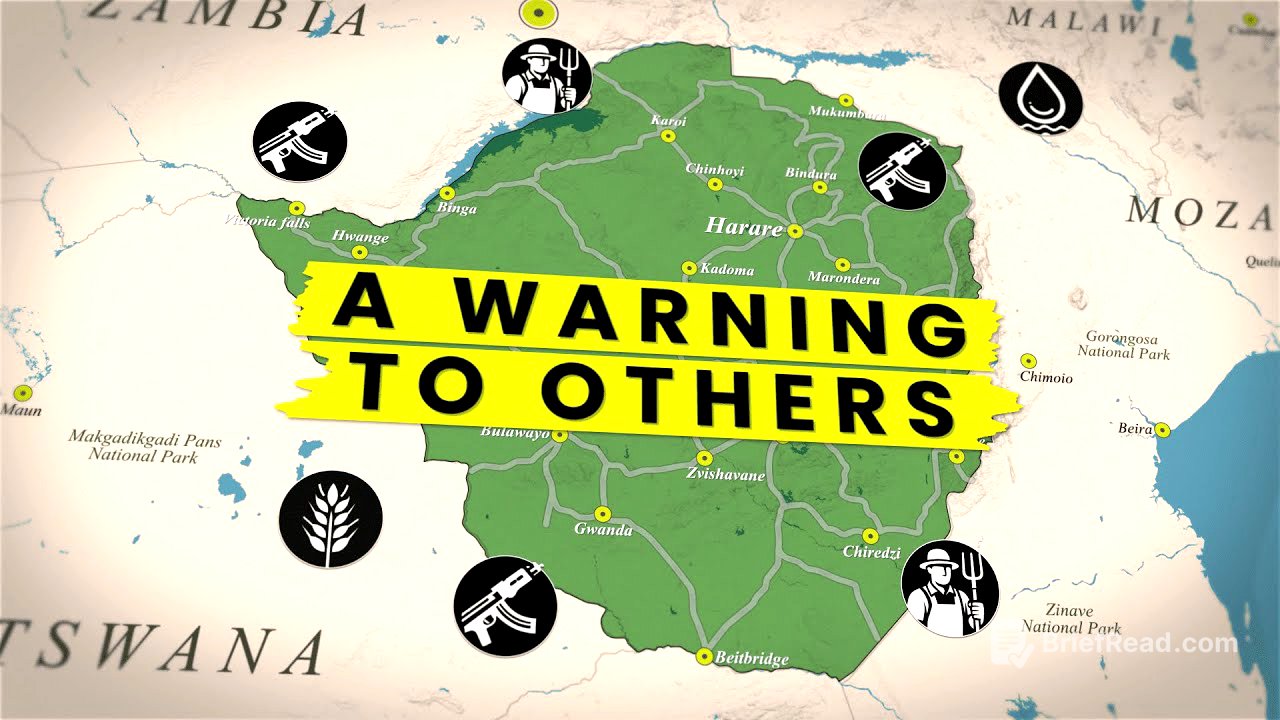TLDR;
This video examines Zimbabwe's economic collapse, triggered by the confiscation of land from white farmers, and the subsequent attempts at reconciliation and economic recovery. It highlights the complexities of land reform, the hyperinflation crisis, and the ongoing negotiations to bring back white farmers while addressing the concerns of indigenous Zimbabweans. The video suggests that the current approach may be a strategic manoeuvre to ease international sanctions and restructure debt, even if it means sacrificing agricultural productivity and overall economic growth.
- Zimbabwe's economic collapse was triggered by land confiscation from white farmers.
- Hyperinflation reached staggering levels, rendering the national currency worthless.
- Current efforts to bring back white farmers are complicated by land ownership issues and lack of trust.
- The government may be using negotiations as a strategy to lift sanctions and restructure debt.
Introduction [0:00]
Zimbabwe's economy is one of the worst in the world, with a significant portion of its population living in extreme poverty. The government is trying to rectify the situation that began with the confiscation of land from white farmers, a decision that led to the country's economic collapse. Since 2017, negotiations have been ongoing to encourage the return of the white Zimbabwean community, but reconciliation is proving difficult due to deep-seated resentment and fears among indigenous farmers about losing their land.
Rhodesia's Independence and the Rise of Mugabe [3:12]
Unlike many African nations that gained independence in the 1960s, Zimbabwe's journey to statehood was delayed, officially becoming a country in 1980. Prior to this, the White Minority Administration of Rhodesia unilaterally declared independence from Britain in 1965, a move that was not recognised internationally and faced sanctions from the United Nations. The failure of these sanctions led to the rise of Robert Mugabe and the Zimbabwe African National Union (Zanu), who initiated a revolution to fight for majority rule and remove the white minority government. This conflict escalated into a civil war, with Angola, Zambia, and Tanzania supporting Zanu, while South Africa backed Rhodesian forces. A ceasefire in 1979 led to elections in 1980, which Zanu won, making Mugabe the prime minister. He then dismantled Rhodesia, renaming it Zimbabwe, a transition that was internationally recognised.
Land Reform and Economic Disaster [5:15]
Despite the political transition, Zimbabwe faced significant challenges, particularly regarding unequal land ownership inherited from colonial times. Initially, Mugabe's government attempted to buy land from white farmers voluntarily, but progress was slow. In 2000, a land reform was initiated, forcibly transferring farmland from white commercial farmers to indigenous Zimbabweans. This programme resulted in violence, corruption, and mismanagement, with much of the land being given to political allies who lacked farming expertise. Consequently, agricultural productivity plummeted, leading to food shortages and a reliance on imports. Western nations imposed sanctions on Zimbabwe due to the displacement of white farmers, further isolating the country economically.
Hyperinflation and Regime Change [7:36]
Mugabe's attempts to address the economic crisis were unsuccessful, with decisions such as printing large amounts of money leading to hyperinflation. By 2008, inflation reached 79.6 billion percent. In 2009, Zimbabwe abandoned its national currency in favour of a multicurrency system, primarily using the US dollar and South African rand, which took nearly a decade to stabilise the economy. In November 2017, a military coup removed Mugabe from power, and Vice President Emmerson Mnangagwa became the new leader.
Efforts to Rebuild and the Return of White Farmers [9:26]
Mnangagwa adopted a more pragmatic approach, acknowledging that the return of white farmers was crucial for rebuilding Zimbabwe's economy. This would increase agricultural production, improve food security, create jobs, and boost exports. To facilitate this, joint ventures were established to encourage white farmers to return, combining their expertise with local resources. While some farmers have returned, the majority remain hesitant due to a lack of trust in the government.
Current Challenges and Compensation [10:40]
A significant issue is that commercial farms operate under lease agreements with indigenous Zimbabweans, preventing a full transfer of land ownership. This arrangement, coupled with the fear among indigenous Zimbabweans of losing their land, places Mnangagwa in a difficult position. In October 2024, the government negotiated to compensate white farmers financially and encourage their return, approving substantial compensation claims. However, only a small percentage of the compensation will be paid in cash, with the remainder in treasury bonds, which are of questionable value given Zimbabwe's economic situation. Additionally, the compensation only covers infrastructure losses, not the land itself.
Political Strategy and International Negotiations [13:45]
The programme to reinstate white farmers may be intentionally designed to fall short of expectations. Zimbabwe is heavily indebted and under Western sanctions, and Mnangagwa's government is engaged in negotiations with the African Development Bank and the United Nations to restructure its debt and lift sanctions. The white farmers' compensation issue is central to these negotiations. By appearing to negotiate in good faith, Zimbabwe aims to convince international powers to ease sanctions and rearrange debt, even if it means limited economic growth and persistent problems. This strategy allows the government to avoid backlash from indigenous Zimbabwean farmers while potentially securing international support.









![This Crypto Crash Will NOT End Here! [Here's Why]](https://wm-img.halpindev.com/p-briefread_c-10_b-10/urlb/aHR0cDovL2ltZy55b3V0dWJlLmNvbS92aS9EbUdyNzlUemp4TS9ocWRlZmF1bHQuanBn.jpg)